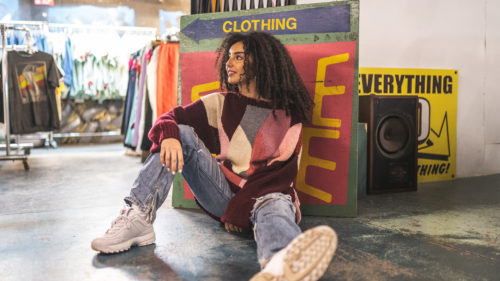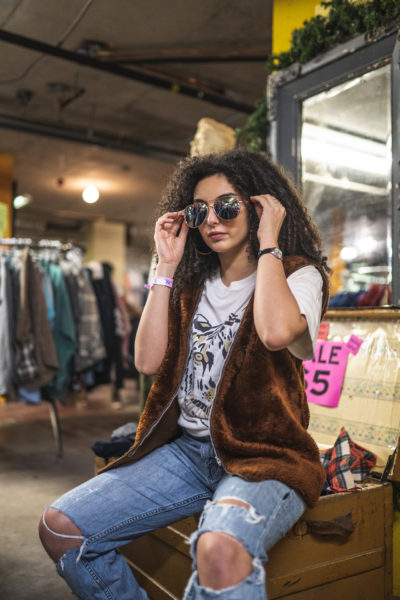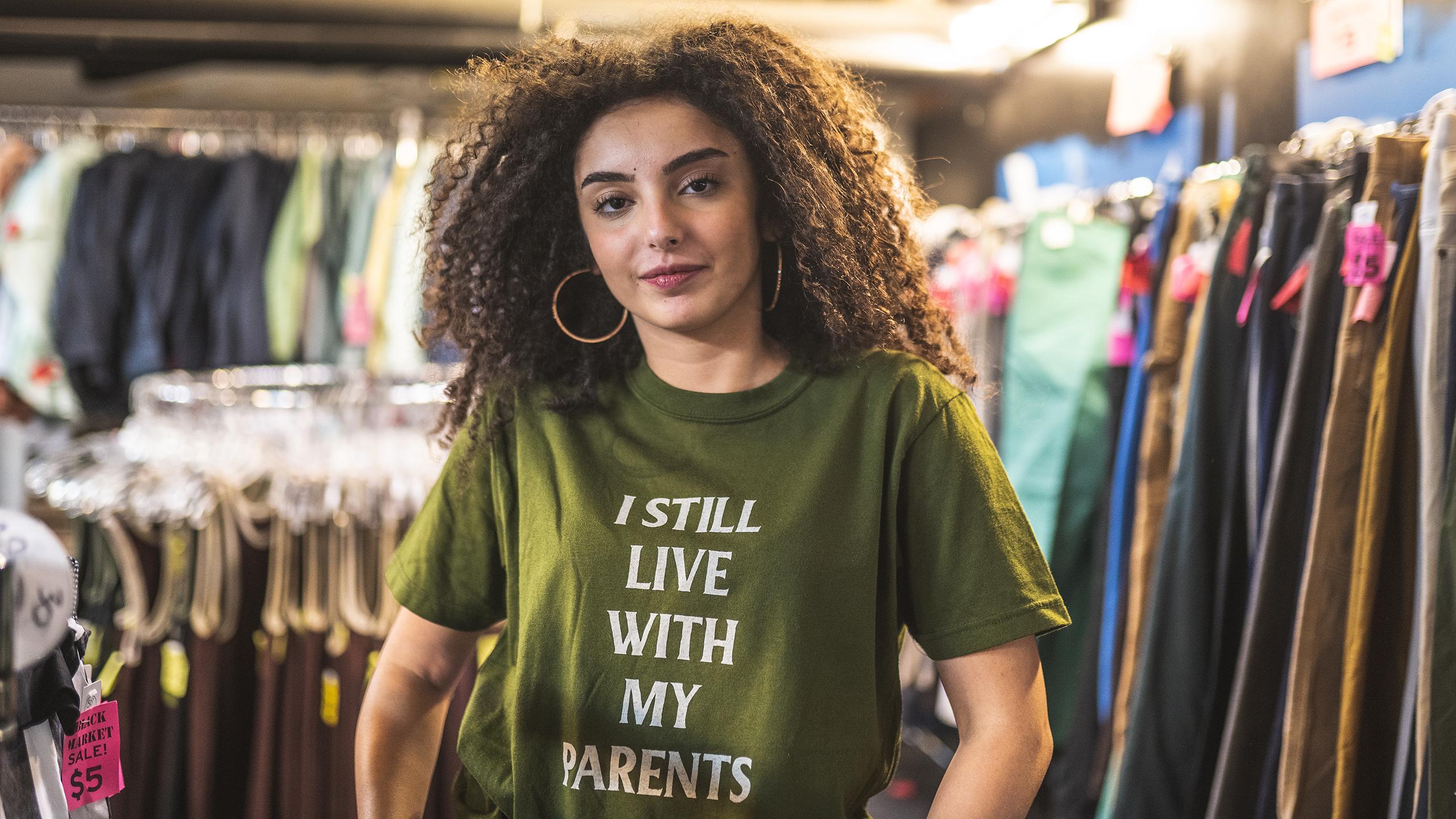WORDS BY KAYLA ZHU AND ANDREA JOSIC
***
PHOTOS BY ELANA EMER, ALL CLOTHING COURTESY BLACK MARKET VINTAGE
While once attached to a “hipster” trope, thrifted clothing has now risen to the forefront of the fashion industry. Its visibility is irrefutable. The prevalence of graphic tees, denim jackets and mom jeans on our social media feeds and around campus is a testament to the permeation of the retro look within youth culture.
From the creation of thrift clothing e-commerce platforms such as Depop and Grailed to the increased clothing prices at Value Village, businesses and online communities are responding to the rising demand for secondhand clothing in a variety of ways.
What sets the thrifting trend apart from most other fads is its demand for authenticity; a quality that cannot be mass-produced or manufactured. This trend doesn’t just manifest itself in aesthetics, but the entire experience of finding and buying used clothing.
The thrift store has effectively become a sacred site where the act of thrifting occurs—which, for some, can be disorganized, claustrophobic and overwhelming. It’s a wholly different type of retail experience, compared to the carefully designed layouts of mall storefronts. In thrift stores, shoppers are left to their own devices as they try to navigate an anarchic microcosm of all sorts of fashion fads and eras.
One key aspect of thrift culture is the elusiveness of higher quality pieces and the laborious process of looking around for anything that will actually fit. The act of digging through mountains of denim and graphic tees for “the perfect find” is cathartic to some and hellish to others.
Enter Instagram resale businesses. These online stores source, curate and sell thrifted clothing on social media sites, often using a third-party service to conduct transactions.
They take the thrifting out of thrift style—allowing shoppers who don’t have the time or energy to embark on a mission inside a second-hand clothing store to still don the thrifted look. Essentially, they’re purveyors, digging into mountains of clothes and resurfacing with pieces so their customers don’t have to.
According to the 2019 Resale Report by GlobalData, which analyzed data from the online second-hand store thredUP, the secondhand market was worth $28 billion. Of that, $7 billion dollars was made from resale and the other $21 billion was made from donations and thrifting. Resale is considered as sales made primarily, but not exclusively, from curated online thrifting. Donations and thrifting are sales made from primarily offline stores, like The Salvation Army and GoodWill.
By 2023, the secondhand market will be worth $51 billion, the report projects, with $23 billion coming in from resale.
***
The business of thrift
The growth of Instagram resale businesses is evident even within the microcosm of Ryerson’s downtown community. Some of these enterprises range from modest sub-200 follower pages to businesses that are shipping orders worldwide, as is the case of David Galluzzo, a third-year sport media student who runs @tdotvintagesupply.
Galluzzo began dipping his toes into thrifting when he began looking around the Value Village location next to the hospital where his grandfather stayed around five years ago.

“Eventually after a few months, I accumulated a bunch of stuff and I said, ‘Okay, I can’t just keep all this because I don’t wear it or use it’,” said Galluzzo.
He started selling his stockpile of clothes on eBay, which quickly grew. Using Instagram as a means of promotion, Galluzzo expanded his business even more until he had to find new suppliers to meet his business’ demand.
Galluzzo’s go-to spot? Rag houses, a.k.a giant textile recycling warehouses of second-hand clothing. These are the sites where donation bin clothing ends up at, and where Galluzzo spends hours scouring for pieces for his shop.
“I’ll spend a few hours and I’ll go through the millions of items they have, like some of these places are hundreds of thousands of square feet,” said Galluzzo. “I end up paying by the pound so I’ll pay about $4.50 to $5 per pound. Every time I go, I can flip that for a good profit.”
From finding a steady supply stream to reaching out to the right audiences, running an Instagram resale business demands entrepreneurial aptitude alongside an eye for fashion. For third-year marketing student Elizabeth Lawless, she found that what she was learning in her program around customer research was directly applicable to her business, @thriftedby_lib.
“At the beginning of the season, I’ll do a series of like eight polls on my stories like, ‘What do you want to see?’ or ‘Do you want t-shirts or long sleeves?’ that kind of stuff,” said Lawless. “I can kind of have a grasp of what people really want, like market research.”
Lawless says using Etsy for the transaction process has streamlined her business processes and believes that putting money into tools like Etsy is worth it in the long run, even for smaller enterprises.
“It’s a good investment, in my opinion, it increases your reach, it shows you your statistics,” said Lawless. “I’ve gotten a few of my new followers from having an Etsy page which is probably like the biggest plus.”
***
Creative challenges for resale brands
Galluzzo’s eye for thrift clothing wasn’t innate, but rather the culmination of extensive research and a keen interest in vintage clothing. His knowledge of brands, clothing production and the used clothing industry mainly derives from research.
“I’m constantly on either Instagram or various vintage forums researching garments down to the stitching and tags and stuff like that,” said Galluzzo.
However, Galluzzo and Lawless don’t just sell anything that’s trending. Instead, they focus on their own personal brands and looks. Galluzzo’s brand consists of an assortment of t-shirts, jeans and jackets ranging from the ’80s to the early 2000s style.
“10 years ago, if you were to go to the thrift store, the demographic of people there versus who goes now is very different”
He uses white particle boards, wooden desks and a variety of softboxes and lighting equipment for his Instagram pictures that he takes with his Google Pixel. Galluzzo says his logo, which is in its third iteration, is inspired by Magnum P.I.
Lawless says her branding has experienced some fluctuation with colours and fonts, but she’s “not too hard on herself” because she believes having a clear brand message is the most important aspect of her business.
“Sustainability and stuff like that, I’m very consistent with,” said Lawless. “My main goal was just to make it easier for people to shop sustainably because a lot of my friends were like, ‘I really want to thrift shop but it takes forever.’”
***
The gentrification of thrift
Thrift stores were initially designed as charities for low-income communities to have access to affordable clothing, yet they’ve increasingly become an outlet for small businesses and resellers to turn a profit.

More recently, there’s been an increase in the price of clothing at thrift stores. Based on the notion of supply and demand, when an item is in high demand but there’s less of it, it’ll become pricier—explaining the rising costs of unique vintage items within thrift stores.
Scott Louch, chief operations officer (COO) at Goodwill Industries, Ontario Great Lakes, said the increase in clothing costs at thrift stores like Goodwill is due to a general increase in the cost of running a business over time. This includes higher rent, transportation and insurance.
Louch says that Goodwill is aware of the fact that people will resell and upsell clothing from their thrift stores. With this in mind, Goodwill will “maximize the value of donations.” This includes pricing brand-name items at a higher value while pricing most of their other items at a lower cost for low-income communities who shop at their stores.
“There’s still access to affordable goods for people that need it,” says Louch. “And for those people that are maybe a little bit more wealthy that still want to shop thrift, there [are] different opportunities for them.”
Louch also believes that shoppers are becoming more conscious of their personal impact on the environment, which includes changing how they shop. This motivates people to shop at thrift stores instead of fast fashion retailers.
According to a report by the Ellen MacArthur Foundation, based on a study of the environmental impact of the fashion industry, greenhouse gas emissions from textile production totalled 1.2 billion tonnes of CO2 in 2015.
Although curated thrift stores are often more expensive, they’re still easier than shoppers having to sift through racks and find unique, vintage, brand-name pieces.
***
Behind the rise of thrift culture
Lawless attributes the popularization of retro clothing and climate change awareness to thrift clothing’s rising presence.
“Climate change in itself has been a big eye-opener for people,” said Lawless. “It causes you to look at what you’re doing and say, ‘I could make these changes, and thrifting is a small change that you can make.”
“10 years ago, if you were to go to the thrift store, the demographic of people there versus who goes now is very different,” said Galluzzo. “If you go to the men’s section and find anything branded, the price will be much more. It’ll be $10 to $15, whereas maybe 10 years ago, it would have been one or $2.”
When sourcing her brand’s clothing, Lawless tries to steer away from bigger retailers like Value Village with higher prices to keep her own prices low.
“When I see them having prices like that, I don’t want to support a company that takes advantage of their consumers,” said Lawless.
Lawless also tries to keep in mind the “demographic that thrifting was made for” when curating her shop’s pieces.
“People ask me for blazers and clothing like that,” said Lawless. “I try not to thrift those things because there are people looking for jobs, just starting out, who might be low-income. That’s the kind of stuff that they need.”










Deb
This is a very informative article. I have been this gentrification before. The Salvation Army thrift store became a big fad back in the 1080’s. When that happened all I could find for lower prices was torn and unwearable clothing. The same thing is now happening at Value Village. Anything in decent condition is over $20.00. There are a few things you can get for !5. This is especially true for larger sizes. Plus size women’s clothing is the most expensive. A decent pair of pants will cost $15 to $20. The lower priced items are all worn out. Some are so bad they have holes in them. It’s sad the wealthy have to make a fad of everything and drive prices up. Thrift stores used to be for low income people.